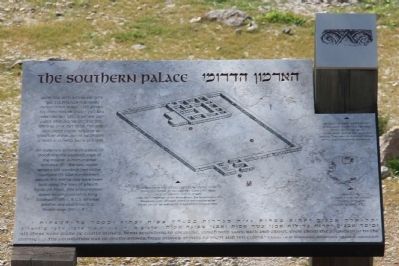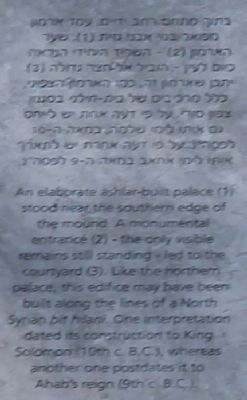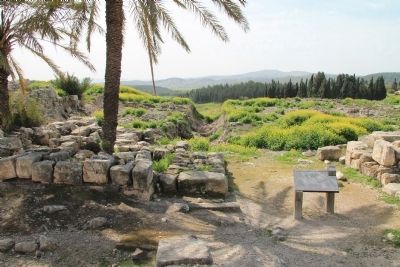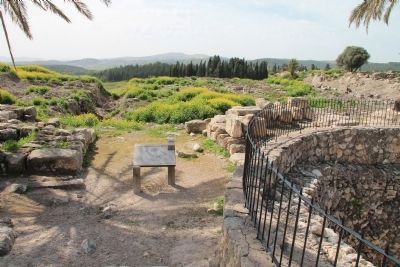Near Megiddo, Haifa District, Israel — West Asia (the Levant in the Middle East)
The Southern Palace
An elaborate ashlar-built palace (1) stood near the southern edge of the mound. A monumental entrance (2) - the only visible remains still standing - led to the courtyard (3). Like the northern palace, this edifice may have been built along the lines of a North Syrian bit hilani. One interpretation dated its construction to King Solomon (10th c. B.C.), whereas another one postdates it to Ahab's reign (9th c. B.C.).
[Text across the Bottom of the Marker]:
"All these were made of costly stones, hewn according to measure, sawed with saws, back and front, even from the foundation to the coping (...). the foundation was of costly stones, huge stones, stones of eight and ten cubits." (1 Kings 7: 9 - 10, describing Solomon's Palace in Jerusalem).
Topics and series. This historical marker is listed in these topic lists: Anthropology & Archaeology • Forts and Castles • Settlements & Settlers. In addition, it is included in the Tel Megiddo series list.
Location. 32° 35.089′ N, 35° 11.065′ E. Marker is near Megiddo, Haifa District. Marker can be reached from National Route 66 just north of National Route 65, on the left when traveling north. This historical marker is located in the Megiddo National Park. The park is located between the Megiddo and Yokne‘am junctions (road no. 66), about 2 km west of the Megiddo junction. The historical marker is situated at the top of Tel Megiddo, near the very center of the southern side of the archaeological park. Touch for map. Touch for directions.
Other nearby markers. At least 8 other markers are within walking distance of this marker. A Public Grain Silo (here, next to this marker); Schumaker's Excavations (within shouting distance of this marker); The Southern Stables (within shouting distance of this marker); The Water System (about 120 meters away, measured in a direct line); The Northern Palace (about 120 meters away); The Northern Stables (about 120 meters away); The Sacred Area (about 120 meters away); A Unique Continuity (about 120 meters away). Touch for a list and map of all markers in Megiddo.
More about this marker. The "Megiddo National Park" handout/brochure has this to say about Stop 14, "The Southern Palace" on the historic tour:
Nothing is left of the southern palace now except the courtyard and the gate you see here, the remains having been dismantled by the Chicago expedition to reach earlier strata. The plan of the southern palace resembles that of the northern palace (7). Near its outer gate, Schumacher discovered the seal with the inscription 'to Shem'a, a servant of Jeroboam.' Apparently referring to Jeroboam
II, this is the earliest seal of an Israelite king discovered to date. Unfortunately, the original seal was lost, leaving only a drawing. The palace has been dated to the tenth century BCE, with some scholars dating it later, to the ninth century BCE and the reign of Ahab.
Regarding The Southern Palace. The text on this historical marker shares two different views on when the Southern palace was built. These two different views are the result of the current split in scholars of Biblical archaeology and history into two camps identified as minimalists and maximalists. I have included two links to help the reader to understand what the significant issues are in these two differing views.
It should be noted that this debate in view points is focused on the period in Ancient Near History from about 1,000 to 800 B.C. (the time period that this historical marker's city-gate falls into) and that the debate is centered around matching the historical timeline of the literature found in the text of the Bible with the historical timeline of the archaeological evidence being found in the lands and physical sites associated with the Bible.
The author of one of these links (who is pro minimalist) writes, "Maximalism and Minimalism: labels for two opinions about the relation between written evidence and archaeology, which sometimes
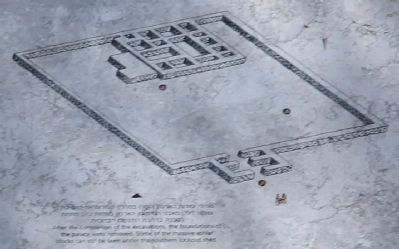
Photographed By Dale K. Benington, March 8, 2013
3. The Southern Palace Marker
Close-up view of the illustration of the Southern Palace displayed on the historic marker. The listed numbered items are as follows: 1) ashlar-built palace, 2) monumental entrance, 3) courtyard. The caption under the picture reads: After the completion of the excavations, the foundations of the palace were removed. Some of the massive ashlar blocks can still be seen under the southern lookout shed.
The author of the other link (who is pro maximalist) writes, "According to the minimalists, the United Monarchy never split into two kingdoms, Judah and Israel, because it never existed in united form in the first place. Their account is that the two kingdoms developed side by side, with the Kingdom of Judah and its capital, Jerusalem, developing at a far later stage, after the consolidation of the Kingdom of Israel in the ninth and eighth centuries BCE. In this interpretation, David and Solomon are entirely fictional figures."
Related markers. Click here for a list of markers that are related to this marker. To better understand the relationship, study each marker in the order shown.
Also see . . .
1. Tel Megiddo. This is a link to information provided by Wikipedia, the free encyclopedia. (Submitted on May 8, 2013, by Dale K. Benington of Toledo, Ohio.)
2. The Megiddo Expedition. This is a link to information provided by The Megiddo Expedition Website. (Submitted on May 8, 2013, by Dale K. Benington of Toledo, Ohio.)
3. Tel Megiddo. This is a link to information provided by the BibleWalks.com website. (Submitted on May 8, 2013, by Dale K. Benington of Toledo, Ohio.)
4. Bit-hilani. This is a link to information provided by Wikipedia, the free encyclopedia. (Submitted on May 8, 2013, by Dale K. Benington of Toledo, Ohio.)
Credits. This page was last revised on December 27, 2023. It was originally submitted on May 8, 2013, by Dale K. Benington of Toledo, Ohio. This page has been viewed 668 times since then and 23 times this year. Photos: 1, 2, 3, 4, 5. submitted on May 8, 2013, by Dale K. Benington of Toledo, Ohio.
